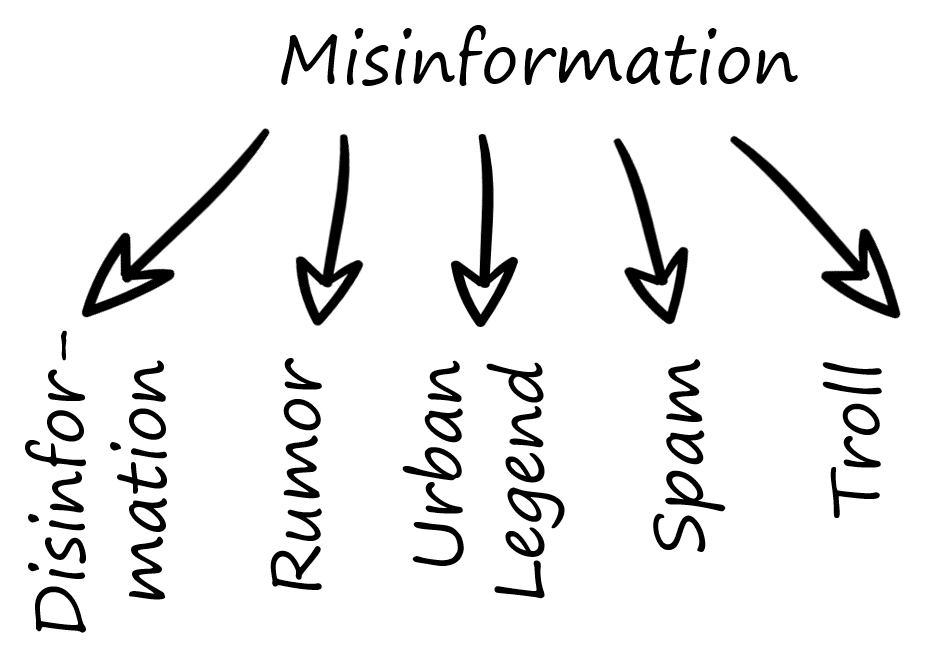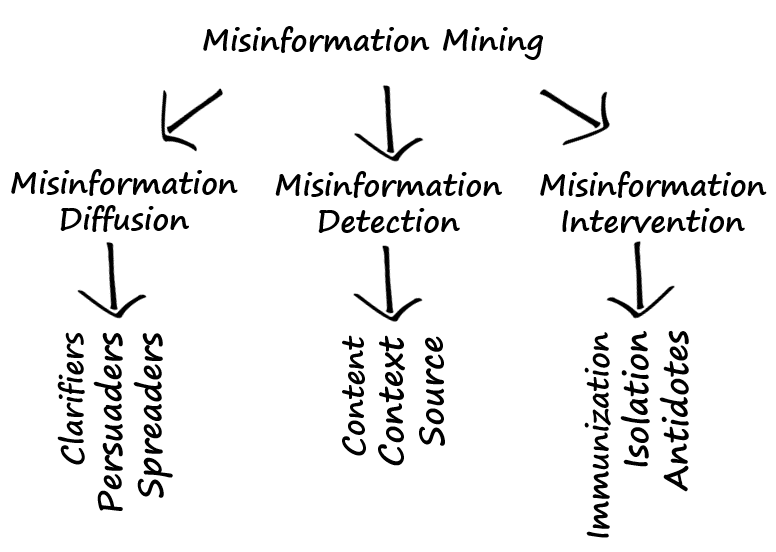Misinformation Key Terms, Explained
Misinformation has emerged as a key issue for social media platforms. This post will introduce the concept of misinformation and the 8 Key Terms, which provides insights into mining misinformation in social media.
By Liang Wu, Fred Morstatter, and Huan Liu, Arizona State University.
Misinformation is fake or inaccurate information that is unintentionally spread. As a prime platform for information dissemination, social media sites inadvertently become a fertile environment where misinformation is widely spread, which may trigger fear and panic in the real world. It is where social media mining can help in battling misinformation via misinformation detection and intervention.
1. Disinformation
Disinformation is fake or inaccurate information that is intentionally spread. The only difference between disinformation and misinformation is the intention of the spreaders. An example of disinformation is the fabricated false statements on Wikipedia made to masquerade as truth. However, in the context of social media, the intent is usually difficult to tell. Therefore, misinformation is usually used to denote fake and inaccurate information in social media, regardless of spreader intentions.
2. Rumor
A rumor is a story circulating from person to person, of which the truth is unverified or doubtful. Rumors usually arise in the presence of ambiguous or threatening events. When its statement is proved to be false, a rumor is a type of misinformation. Therefore, among efforts in fighting against rumors, methods usually consist of two steps: rumor detection and truthfulness prediction.
3. Urban Legend
An urban legend is a fictional story that contains themes related to local popular culture. The statement and story of an urban legend are usually false. The story of an urban legend is usually describing unusual, humorous, or horrible events. In some cases, urban legends are based on true and actual occurrences that have, in their telling and retelling, been distorted or exaggerated. The corresponding story becomes inaccurate or false due to the distortion and exaggeration.
4. Spam
Spam is unsolicited messages sent to a large number of recipients, containing irrelevant or inappropriate information, which is unwanted. Spamming messages are usually involved with spreading ads, malware, and even leading to scams. Spam is not necessarily misinformation, since some piece of information may be true and unsolicited simultaneously. However, spam that conveys misinformation can directly leads to information and financial loss.
5. Troll
A troll is a user who posts messages that are deliberately offensive or provocative, with the aim of upsetting other people. Trolling content is often happening in conversations, disrupting normal on-topic discussions and leading to emotional responses. The content trolls post is usually nonsense, and the troll spreaders post them for their own amusement.
6. Misinformation Diffusion
Misinformation diffusion studies how misinformation spreads in a network. Spreaders are those nodes between source and target nodes. In misinformation diffusion, there are in general three types of nodes: spreaders, clarifiers, and persuaders. Spreaders disseminate misinformation, clarifiers illuminate the falsehood, and persuaders try to change users’ beliefs. Misinformation spreaders can be further categorized into intentional or unintentional. Intentional spreaders disseminate disinformation include fraudsters, spammers, and trolls, while unintentional spreaders are users who happen to believe in the false information.
7. Misinformation Detection
Misinformation detection is the process of designing techniques to find misinformation on social media networks. The detection process usually employs the content, context and source of misinformation. Because the early detection of misinformation can effectively prevent it from spreading widely within a network, timeliness is also a crucial metric to consider in addition to more traditional performance metrics such as precision and recall.
8. Misinformation Intervention
Since the diffusion of misinformation on social media networks can be seen as a virus spreading among users, preventive and anti-epidemic measures can be used to fight against misinformation such as immunization, isolation, and antidotes.
- Misinformation immunization: Warnings of specific misinformation are sent to targeted groups of people, like how colleges warn freshmen of on-campus scams.
- Misinformation isolation: Social media platforms suspend malicious users, the suspension quarantines misinformation from spreading to general users, thus preventing them from being infected.
- Misinformation antidotes: When misinformation goes viral, disseminating misinformation-dispelling statements by relevant authorities is essential to effectively terminating the spread. When misinformation regarding the presence of Ebola in Iowa began spreading on Twitter, the Iowa state government released a statement indicating that there were no cases of Ebola in the state.
For more details, please find the tutorial slides at bit.ly/misinformation-tutorial
Related:


